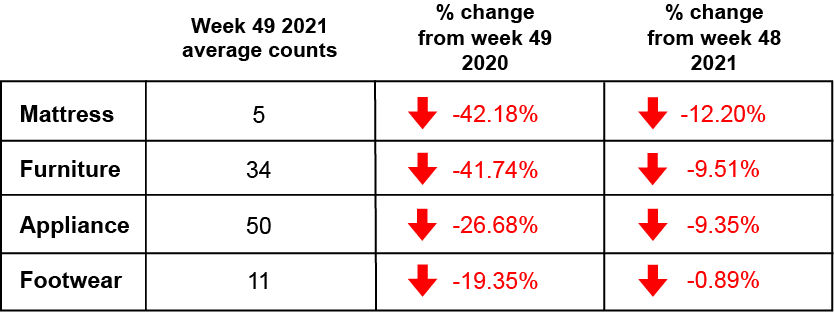As the Internet of Things and new technologies are becoming more widely adopted by consumers, 2022 could force the hand of many retailers to adopt the technologies in their stores.
With analysts expecting only a 5% increase in projected sales for 2022 after reaching nearly 30% this year, reducing any friction at checkout or during the customer journey will be essential in 2022.
This week we dive into predictions for retail in 2022 and the top trends we expect to see in the next year.
THIS WEEK’S HIGHLIGHTS
- Sales forecasting: What can we expect from shoppers in 2022?
- Physical stores: The strive for efficiency and personalization
- The internet of things: How increased adoption has changed how people experience retail.
FOOT TRAFFIC INDEX
Here’s a look at last week’s foot traffic compared to the same time last year.

FOOT TRAFFIC TRENDS
Industry insights so you can convert your foot traffic into more sales.
Retail: 2022 predictions
Predicting the future of retail has proven to be a nearly impossible task with the retail environment and trends changing every week.
Moody’s Analytics, which provides financial intelligence and analytical tools for a variety of different industries, predicts that 2022 will be a year of growth for the retail industry.
For 2022, Moodys predicts that operating income will increase by 5% year-over-year. Although 5% isn’t much, it would be quite the achievement considering that 2021 is closing in on 30% growth compared to 2020.
This year, we’ve already seen nearly 10% growth in projected sales growth, with 2022 expected to see another 5% improvement.
Even with e-commerce and online sales expected to continue gaining popularity, curbside pickup and BOPIS have proven to give people the best of both worlds.
Brick and Mortar: the strive for efficiency
As getting shoppers into your store has become increasingly difficult with online stores finding a way to compete in large-ticket industries such as furniture and mattress, stores are constantly searching for ways to personalize the shopping experience that consumers can’t find online.
As we touched on last week, scheduled shopping experiences are a new trend that many retailers are picking up on. By scheduling a shopping trip with a consumer, customers feel a level of personalization and are more likely to buy.
Some companies are taking personalization to the next level by opening smaller stores specifically to enhance the customer experience. Not only does a smaller store help retailers be able to compete with the prices of e-commerce with lower rents, but it allows you to find a location closer to customers.
Ikea recently announced they are opening “planning studios” as a way to have stores closer to consumers and give them the option to sit down with a designer and plan out their living space.
Going forward, personalization will be the name of the game to keep physical stores competitive.
Must-watch trends
As the internet of things continues to become cheaper and more widely adopted by consumers of all ages, it has become increasingly important for stores to adapt to new technologies that make it easier for shoppers to cross the buying line.
The Internet of things describes physical objects that are embedded with sensors, processing ability, software, and other technologies that connect and exchange data with other devices and systems over the Internet or other communications networks.
This includes having an up-to-date checkout process, such as having touch-less checkout and allowing for payment methods such as Apple Pay. When in doubt, give customers every option possible to avoid friction. Even my dad uses his Apple watch to pay for nearly everything these days, and he is far from a tech-guru.
As we’ve continued to see, online research before entering a store is a common practice for many shoppers. Not only is it a common practice, but consumers have come to expect online inventory to match what the inventory is in-store. While that continues to be important, it’s evident that it is easier said than done.
Lastly, data privacy has become very appealing to many shoppers. People want to know what data is collected, and what you are going to do with it. Being clear on your data privacy guidelines will help gain trust and peace of mind for customers.
Retail Snippets
Return season: Consumers could return $66.7B in holiday merchandise this year.
Relational economy: Why emotional customer connections are the new foundation.
A year of sales: A look into the monthly retail sales from the US Commerce Department.
Shopping outlook: Omnichannel, the metaverse, and creativity in marketing.
RANDOM IRRELEVANCE
A first: Humans just ‘touched’ the sun for the first time using a spacecraft.
The Matrix: Scientists force human brain cells into a Matrix-like simulation.
Watch: 12-year-old Charlie Woods’ back-to-back solo birdies at PNC Championship.
